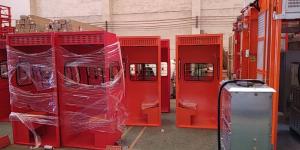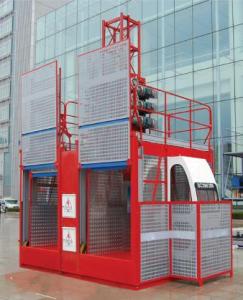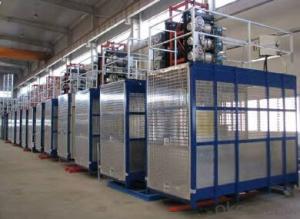High quality hot seller building hoist SC200/200 0-33, 0-46, 0-63, 0-96
- Loading Port:
- Qingdao
- Payment Terms:
- TT or LC
- Min Order Qty:
- 1 unit
- Supply Capability:
- 10 unit/month
OKorder Service Pledge
OKorder Financial Service
You Might Also Like
Building Hoist Description
Condition: New
Application: Construction
Payload(kg):2*2000
Lifting Speed(m/min):0~40
Motor Power(kw): 2*3*22
Safety Device: 2*SAJ50-1.4
Cage: Single/double cages
Counterweight: No
Certification: CE/ ISO
Place of Origin: China(Mainland)
Model Number: Type:SCD200/SCD200
Packaging & Delivery of Building Hoist
Packaging Detail: Nude package Delivery Detail: 10-20days
Main Parts of Building Hoist

Feature:
● Adopts the most advanced VF speed control device and microcomputer programmable logic controller.
● Stepless speed control helps eliminate the concussion during start up and braking, steady the operation process,
and ensures automated leveling.
● The steadiness during running mitigates concussion to mechanical parts, reduces wears of rack, pinion and the brake
and prolongs the spare parts'life.
● The VF system also has the over voltage protection,low voltage protection, overcurrent, overload and anti-stalling protection functions,
● The system applies the special software for hoists developed by our company, making the operation more safe and
reliable.
Building Hoist Specifiction
FAQ of Building Hoist
Q: What is the building hoist main purpose?
A: Building hoist equipped with double or single cabin to transport the materials and labors up and down. It's the ideal
construction equipment for vertical transportation in the field of construction.
Q: What is the meaning of the building hoist’s code?
A: Take SC200/200 for example: “SC” stands for rack and pinion hoist, “200/200” stands for double cage and capacity
is 2 tons per cage. “SC200” stands for single cage and capacity is 2 tons.
Q: What is the dimension of the cage?
A: Normally the cage dimension is 3X1.5X2.5M (L/W/H) for 2t type hoist. Details should be checked according to our
quotation sheet. Also, the size can be customized according to the factual site condition. There are two doors (entrance
& exit doors) for each cage, It can be produced as up & down sliding or ramping model for safety and convenience.
- Q: What are the safety measures to be taken to avoid accidents involving lifting equipment on construction sites?
- <p>To prevent accidents related to lifting equipment in construction work, several key safety measures should be implemented. These include regular inspections and maintenance of lifting equipment to ensure it is in good working order. Operators must be trained and certified for the specific equipment they are using. Safe lifting practices should be followed, such as using proper lifting techniques, not overloading equipment, and ensuring the load is balanced. A thorough risk assessment should be conducted before each lift, and a competent person should supervise the operation. Additionally, clear communication protocols should be established, and all workers should be trained in recognizing and avoiding hazards associated with lifting equipment.</p>
- Q: This question asks for the method to determine the maximum weight a building hoist can safely lift.
- <p>To calculate the load capacity of a building hoist, you must consider several factors. First, refer to the manufacturer's specifications for the hoist model in question, as they will provide the maximum load capacity. Check the hoist's mechanical components, such as the motor, cables, and pulleys, to ensure they are in good condition and can support the intended load. Factor in the weight of the materials to be lifted, including any containers or attachments. Consider the hoist's speed and lifting height, as these can affect stability and safety. Always adhere to safety regulations and never exceed the manufacturer's specified load capacity to prevent accidents and equipment damage.</p>
- Q: This question asks for steps to ensure that lifting equipment is safe and reliable before it is used.
- <p>To ensure your lifting equipment is safe and reliable before use, follow these steps: Inspect the equipment for any visible damage or wear. Check all safety features such as hooks, cables, and brakes. Ensure that the equipment is properly maintained and serviced according to the manufacturer's guidelines. Verify that all safety certifications and inspection records are up to date. Conduct a thorough pre-use check, including testing the equipment's lifting capacity and stability. Ensure that all operators are trained and certified to use the equipment. Never use equipment that has not been inspected or is showing signs of damage. Always follow the manufacturer's guidelines and safety protocols.</p>
- Q: The difference between the derrick and the construction elevator?
- They're the same. HAULOTTE answer for you
- Q: This question asks about the procedures and practices for regularly maintaining and inspecting a building hoist to ensure its safe and efficient operation.
- <p>Regular maintenance and inspection of a building hoist are crucial for safety and efficiency. It involves daily checks before use, including visual inspections for any visible damage, proper functioning of safety devices, and ensuring the hoist is clean and free of debris. Weekly inspections should focus on the mechanical components, such as gears, cables, and brakes, and checking for any unusual noises or vibrations. Monthly inspections may include more in-depth checks of the electrical systems and the structural integrity of the hoist. Annual inspections typically involve a thorough examination by a certified professional, who will assess the overall condition and safety of the hoist, ensuring it complies with all relevant safety standards. Always follow the manufacturer's guidelines and local regulations for maintenance and inspection schedules.</p>
- Q: Is it possible to use a building hoist to lift various types of materials?
- <p>Yes, a building hoist can be used for lifting different materials. It is designed to handle a wide range of loads, from construction materials like bricks and cement to heavy equipment. However, it is crucial to ensure that the materials being lifted are within the hoist's weight capacity and that they are properly secured to prevent accidents. Always follow the manufacturer's guidelines and safety regulations when using a building hoist to lift various materials.</p>
- Q: Is it permissible to use a building hoist for lifting people or animals?
- <p>No, building hoists are not designed for lifting people or animals. They are specifically engineered for the transportation of materials and construction equipment. Using a building hoist for this purpose is dangerous and can lead to accidents. It is essential to adhere to safety regulations and use appropriate equipment for lifting people or animals to ensure their safety and comply with legal standards.</p>
- Q: This question asks about the safety measures that should be taken to ensure the safe operation of a building hoist during lifting.
- <p>To ensure the safety of the lifting operation of a building hoist, several key measures should be taken: Regular inspection and maintenance of the hoist equipment to ensure all components are in good working order. Adherence to the manufacturer's guidelines and safety standards for operation. Proper training for operators to ensure they understand how to use the hoist safely. Implementing a safety checklist before each use. Ensuring the load is secured properly and does not exceed the hoist's weight capacity. Using appropriate safety gear such as safety harnesses and helmets. Having a spotter or signal person to assist the operator and watch for potential hazards. Regularly checking the weather conditions to avoid operating in high winds or other adverse weather that could compromise safety.</p>
- Q: This question asks whether a building hoist can be utilized to lift various objects with differing weights and dimensions.
- <p>Yes, building hoists are designed to lift a variety of objects with different weights and sizes. They are versatile and adjustable, allowing for the transportation of materials such as bricks, concrete, and equipment. However, each hoist has a specific weight capacity that must not be exceeded. It's crucial to ensure that the objects being lifted are within the hoist's capacity and that the hoist is properly configured for the size and shape of the objects to ensure safety and efficiency.</p>
- Q: Should a fire extinguisher be equipped in the construction elevator?
- The dual-purpose construction elevator should be needed
Send your message to us
High quality hot seller building hoist SC200/200 0-33, 0-46, 0-63, 0-96
- Loading Port:
- Qingdao
- Payment Terms:
- TT or LC
- Min Order Qty:
- 1 unit
- Supply Capability:
- 10 unit/month
OKorder Service Pledge
OKorder Financial Service
Similar products
Hot products
Hot Searches
Related keywords




























